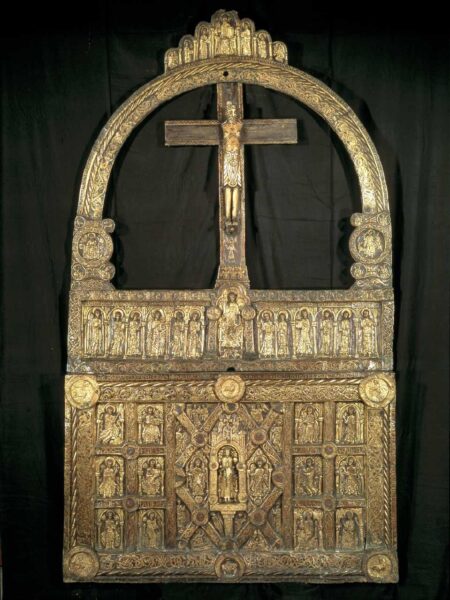The Lisbjerg Altar belongs to a group of eleven golden altars from c. 1100 – 1200 Scandinavia. Two remain in their original surroundings, while five are kept in the National Museum in Copenhagen, and four more abroad.

The Lisbjerg Altar is composed of two parts, a crucifix from c. 1050 – 1080 and the frontal, retable (reredos) and “Arch of Heaven” from c. 1135. The latter part has been dendrochronologically dated.
Measuring 57 cm, the crucifix has lost its arms. It is carved out of oak and covered with chased and gilded copperplates. Afterwards, the plates have been varnish to deepen the reliefs. The figure of Christ belongs to the very early type, where he is rendered as a mighty king. The size, the style and the construction indicate that this crucifix is slightly earlier than the frontal and retable including the heavenly arch above. It belongs to a group of similar crucifixes like the one from Åby, c. 1050 – 1075 and another from Tirstrup c. 1150 – 1200. The motive of the victorious Christ-King is similar to the carved figure of Christ on the large Jelling Stone.
The main motive of the chased, embossed, engraved, and gilded plates covering the frontal is the enthroned Maria holding an apple in one hand while the other is busy cuddling Jesus sitting in her lab. Surrounding her are scenes from the life of Maria, six prophets, a number of virtues and symbols, signs for the evangelists and fabled animals and figures. Impressive are the ornamented leaves and vines encircling medallions holding more or less fabled figures. While the other altars are constructed with a similar large panel depicting either Christ in the Mandorla or the Virgin, the Lisberg altar differs in its meagre use of narrative scenes.
The retable shows the enthroned Christ, one hand raised as in a blessing, the other hand holding a book. At his feet are two lions. To each side, the apostles are lined up. Beneath is a band with an inscription (Math. 19,27 – 28).
The decoration is inspired by English, Irish and Norman design as well as late Viking styles with its interwoven snakes, animals and plants (“dyreslyng” and “ormeslyng”).
It has been speculated whether the altar was made for the new Cathedral in Århus in the beginning of the 12thcentury. And afterwards presented to Lisbjerg in the later half of the 16thcentury. More likely, though, is the hypothesis that the altar was made for Lisbjerg at the beginning of the 12thcentury, when the bishop was still residing at the manor, excavated in the late 20thcentury.
In 1862, the altar was transferred to the National Museum of Copenhagen, since the congregation had moved it aside in order to get a more romantic “look”.

READ MORE:
Gyldne Altre – Jysk Metalkunst fra Valdemarstiden
By Poul Nørlund
København, 1926 (Århus, 1968).
Lisbjerg Kirke
I: Danmarks Kirker
Nationalmuseet 1966
SEE MORE:
Lisbjerg Altar by Kornbluth Photo
